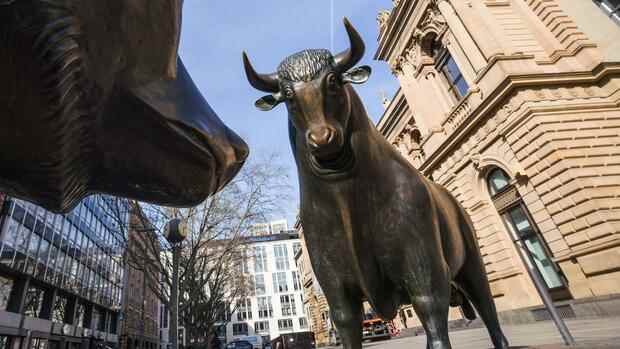It is a market phase characterized by great uncertainty.
(Photo: dpa)
Dusseldorf The investor sentiment in the Dax-Sentiment survey by the Handelsblatt has changed significantly after the price jumps of the past week and shows the biggest change in mood of the year. Just a week ago it was neutral, now it is at the highest level for the entire stock market year 2022.
The basis for the turnaround was: The Dax rose by 5.7 percent in the past trading week. But that shouldn’t have been the end yet.
In the opinion of the sentiment expert Stephan Heibel, who evaluates the Handelsblatt survey, “such a mood stimulus has often led to a few friendly stock market months in the past”. In the medium term, over a few months, the situation has brightened up noticeably and significantly higher prices are possible until next spring.
But in the short term, the situation looks different. “The survey participants are fully invested,” points out Heibel. Further price impulses in the Dax can only come from foreign investors in the coming days.
Top jobs of the day
Find the best jobs now and
be notified by email.
A rapprochement between US President Biden and China’s President Xi, who held personal talks on Monday at the G20 summit, could draw foreign investors’ attention to the Dax: After all, the leading German index is internationally considered an “export index”.
However, without fresh impetus, the rally is likely to take a breather in the short term. “This does not necessarily have to be accompanied by declining prices, but can also take the form of sideways consolidation,” explains the sentiment expert.
From a fundamental point of view, there was constructive progress in three out of four trouble spots:
- Ukraine makes important land gains against Russia.
- China relaxes corona regulations for international business travelers.
- Inflation is falling, at least in the US.
Only one concern remains: will the energy supply be sufficient in winter?
“It was hardly conceivable to get worse”
But it wasn’t just these advances that caused this rally. According to Heibel, the stock markets have not risen because the problems have disappeared or because solutions are in sight.
“They rose because the mood was so negative seven weeks ago that a further deterioration was hardly conceivable.” That alone was enough to alleviate the selling pressure, prices rose without any positive reports. Only now, seven weeks later, are there first signs of hope in the various crisis areas.
The Dax has risen by 17 percent in the past seven weeks. As early as September 26, the sentiment expert predicted in a video that the mood for the Dax in the following six months would mean an average price increase of 17 percent. Just seven weeks later the time had come.
>> Read also: China is relaxing its corona policy somewhat – and is triggering price jumps on the world markets
The US dollar, on the other hand, is in a downtrend. If the currency continues to show weakness, Heibel believes that would be positive for US stock markets. Because their international companies would be able to report their profits made abroad at a more favorable rate.
Current survey data
The Handelsblatt sentiment survey recorded the biggest swing in sentiment this year: Sentiment rose by five percentage points and, at 4.7 percent, also marked by far the highest level of the year.
But the uncertainty is only slowly disappearing. The value of minus 0.3 as a result of the complacency/uncertainty sub-survey shows that many investors are following this price jump in disbelief.
The future expectation of the Dax development in three months follows the drastic change in mood only hesitantly. After minus 0.3 percent in the previous week, this has risen to currently plus 0.5 percent. There is only tentative optimism.
The willingness to invest, on the other hand, is slightly down at plus 1.6 compared to the previous week when it was plus 2.5.
The put/call ratio on the Frankfurt derivatives exchange Eurex, where institutional investors hedge against price losses, is 1.2 and indicates a clearly optimistic positioning. In the USA, too, the put/call ratio of the Chicago futures exchange CBOE shows that investors are bullish.
More bears than bulls
US fund investors, on the other hand, left their investment ratio at the moderately low level of 54 percent compared to the previous week. Although this level is comparatively high against the background of a stock market year that has been catastrophic so far, the average investment rate in recent years was around 80 percent.
The bull/bear distribution of US private investors was collected on Wednesday, i.e. immediately after the first results of the US midterm elections and before the price jump after the US inflation data. The bear camp has grown from 33 percent to 47 percent, while the bull camp has shrunk from 31 percent to 25 percent.
The “fear and greed indicator” of the US markets, calculated using technical market data, is listed in the moderate range at 63 percent. Short-term technical indicators have been in overbought territory for weeks and are likely to have risen significantly over the course of the past few trading days. This signals a short-term breather.
There are two assumptions behind surveys such as the Dax sentiment with more than 7,500 participants: if many investors are optimistic, they have already invested. Then only a few are left who could still buy and thus drive prices up.
Conversely, if investors are pessimistic, the majority of them have not invested. Then only a few can sell and thus depress the courses.
Do you want to take part in the survey? Then let yourself be automatically informed about the start of the sentiment survey and register for the Dax sentiment newsletter. The survey starts every Friday morning and ends on Sunday afternoon.
More: Investors make these ten mistakes from the point of view of stock market psychologists

